Sukiyaki Beef Udon is a homestyle Japanese Hot Pot (nabemono) recipe with delicious beef, mushrooms, udon noodles and vegetables in a rich soy mirin dashi broth cooked at the table family style.
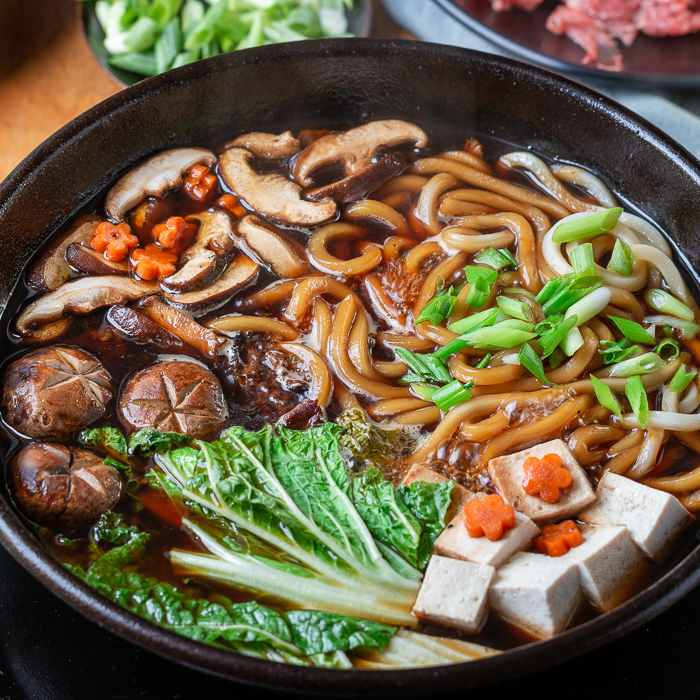
When the weather gets chilly outside, there is nothing like a delicious pot of homemade Beef Sukiyaki Udon to warm you right up. If you are feeling cold, tired and can hardly keep your eyes open to function in the kitchen, the pure and healthy warming ingredients of a beef sukiyaki is sure to please.
You are just going to love Sukiyaki (すき焼き) because…
Fun in interactive dinner to enjoy with family and friends
Easy to prepare
On your table in under 30 minutes
Great way to use up those little bits and bobs of vegetables in your crisper
Warming and good for your spleen qi
Nourishing
What is Nabemono?
Have you ever eaten sukiyaki, shabu shabu, Chankonabe, Yudofu, oden or any other regional specialties made in Japan? If you have, they are all part of a large group of recipes called nabemono or sometime nabe for short. In Japanese, this term nabemono can be loosely translated to "things in a pot". The "things" in the pot can be different and so can the broth. However, we know one thing for sure that everything is delicious. The concept of a hot pot is common in many cuisines. Be sure to try our Simple Spicy Thai Hot Pot or our Chinese Heart of Fire (huoguo) hot pot.
What is difference between Sukiyaki and Shabu Shabu?
Both Sukiyaki and Shabu Shabu are a type of nabemono Hot pot but the main difference in the broth. Shabu Shabu is made with a very simple kombu (seaweed) broth and is a very light and delicate broth. Most generally, people enjoy dipping their shabu shabu in different savory sauces after cooking in the pot.
Sukiyaki Beef Udon is a little sweet and savory flavorful broth and does not require any additional sauces but sometimes people like to dip into raw egg.
What is Sukiyaki?
Sukiyaki is a delicious type of nabemono made with thin slices of beef, mushrooms, shiitake mushrooms, vegetables, tofu, noodles and this rich flavorful sweet and savory broth made with soya sauce, mirin and dashi.
Did you know that there are two main type of sukiyaki?
- Kansai style sukiyaki is made by first grilling the thin sliced beef with a little sugar to brown before adding the broth and the rest of the ingredients.
- Kanto Style sukiyaki gets the broth going in the pot and adds all the ingredients at once. They do not brown their meat first.
Our dear friend from Osaka, Yuko-san, taught us her Kansai version of sukiyaki beef udon from Osaka.
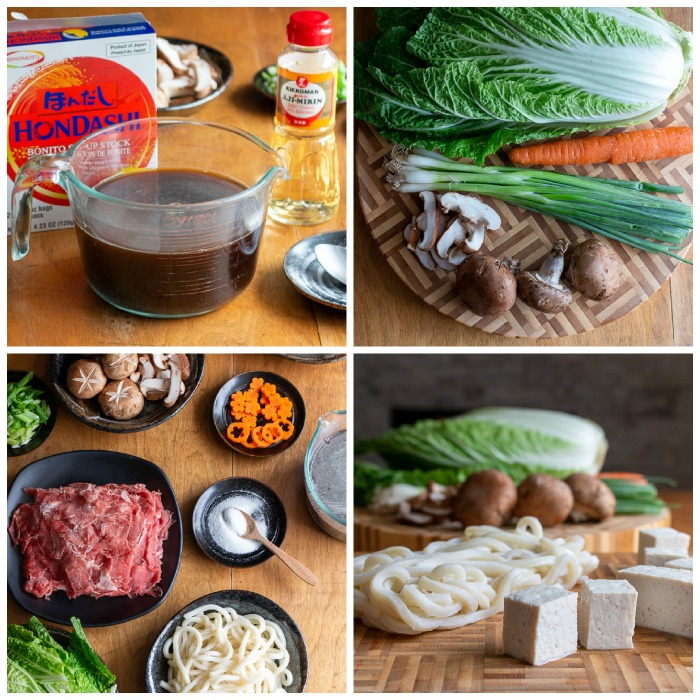
What ingredients are generally used to make sukiyaki?
Ingredients and broth ingredients vary from region to region and from family to family. You can actually use any vegetables you have in your crisper.
Soya sauce
Dashi broth
Mirin
Sake
Negi (Japanese leek)
Napa cabbage or any vegetables in your crisper
chrysanthemum leaves
tofu
udon (or noodles of choice)
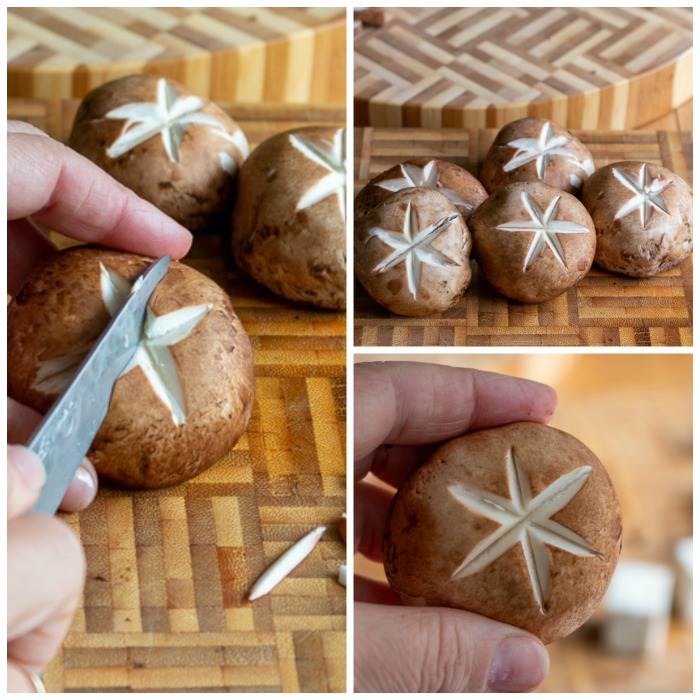
How to make Decorated Carved Mushrooms?
It is not required that you carve and decorate your mushrooms. However, look how cute are these little guys are? Take your knife at a 45 degree angle and cut into mushroom about 1/16 of an inch and then in the opposite side do the same. You will then turn your mushroom and carve two more sections so that it looks like a flower.
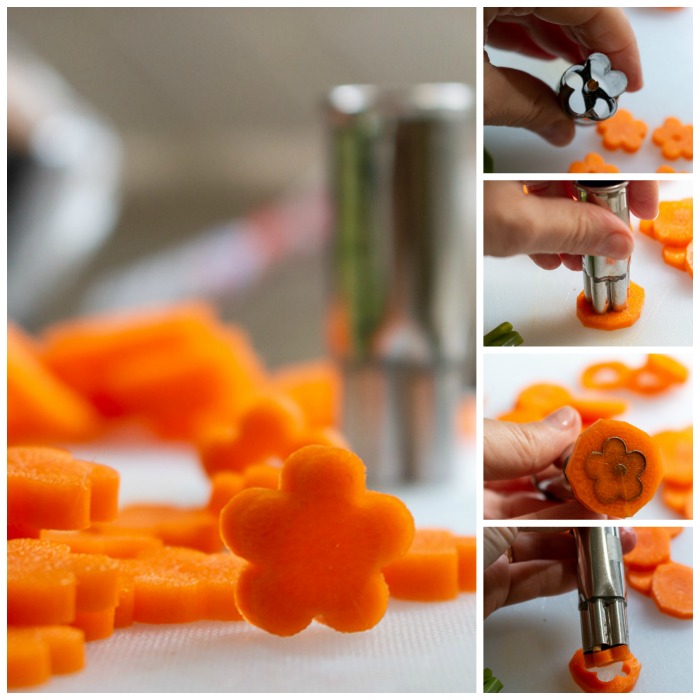
Kawaii Carrots
Kawaii means cute in Japanese. These little carrot flowers are super cute but absolutely not required. Alternatively, you can slice your veggies and pop them in the pot and call it a day.
However, we spent many days making bento boxes for the boys so we have all these cute little cutters and tools from the Hakyuyen (Japanese Dollar) stores. If you want to make a design or a flower and don't have a vegetable stamper, you can peel your carrot and cut a 45 degree both ways. Then, cut along 3 sides of the carrot and slice. You will have a cute flower. On your next adventure to Hong Kong, check out Shanghai Cooking Street this is a must try for any foodie. You will find a galore of cute food stamps .
Udon for Noodles Without Borders!
Welcome dear friends to another fantastic noodles without borders edition. Every first Tuesday of every month, Jas from All That's Jas and Healthy World Cuisine bring to you a noodle recipe from around the world. If you have not guessed it by now, today we are visiting Japan. Come and join in on the fun. If you make one of our noodle recipes or one of your own use the hashtasg #NoodlesWithoutBorders on Instagram and tag @hwcmagazine and @allthatsjas on Instagram for a chance to be featured on our stories. Hop on over to All That's Jas to see what country and recipe she is making today.
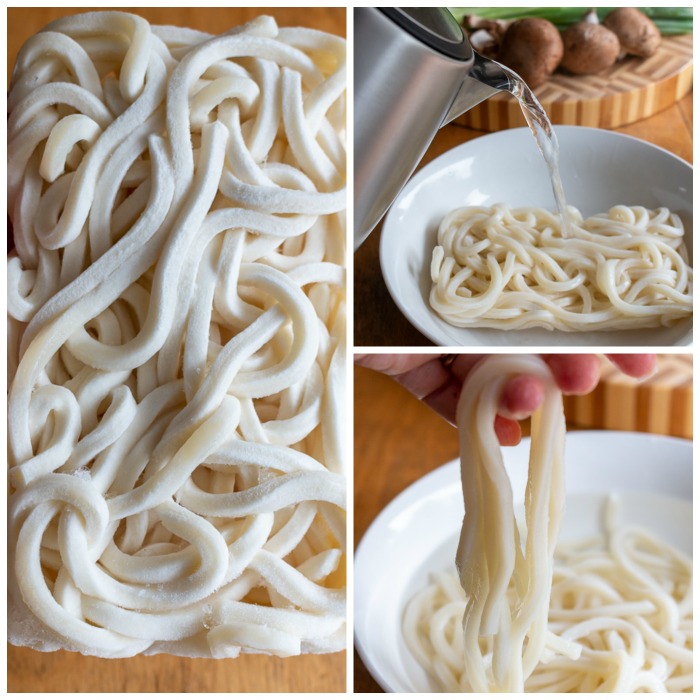
Easy Substitutions for Hard to Find Japanese Ingredients
Traditionally Sukiyaki Beef Udon will also have negi (Japanese leek) and chrysanthemum leaves which are both very difficult to find outside of Japan. We substituted green onions for the negi or you can use leeks. In addition, we used bok choy instead of chrysanthemum leaves. If you can find chrysanthemum leaves, they impart a delicious slight bitter note to the broth that is quite addictive. Only plunge the leaves in the sukiyaki broth a moment or two to cook.
Mirin is a type of Japanese rice wine that is sweet and is used for cooking. In the US, it is difficult to find the REAL mirin but you can find Aji-mirin (tastes like mirin) which is rice wine with added sugars. A very important note the REAL mirin is the best, 2nd choice is Aji-mirin.
If you cannot find either, you can use a sweet marsala wine with a little additional sugar to mimic mirin. We used Aji-mirin for this recipe. Please note that Aji-mirin in our opinion is sweeter and savorier that the real mirin, so you will have to adjust the seasonings to your own personal preference.
There are 3 kinds of sake. First there is the expensive delicious drinking sake. Second there is cooking Sake which is slightly sweetened. We used cooking sake for our Sukiyaki Beef Udon. There is also a low sodium cooking sake and this type would be preferred, if you can find it. If you use the expensive drinking sake, then you will need to add a little extra sugar to make your sukiyaki the flavor profile you are looking for.
Another big finding is that using tamari sauce is super salty compared to regular soy in this recipe. If using tamari, reduce the amount to ⅓ of this recipe.
Hon-dashi comes in granules and you just add water to make the broth. You can find hon-dashi online and at many supermarkets around the world. If you have kombu and bonito flakes, you can make your own dashi at home. It's all about the umami.
Sukiyaki Raw Egg Dip: Yes or No?
In the US, unpasteurized eggs carry the risk of salmonella. Did you know that they do not have salmonella in Japan? I remember walking into many grocery stores and the eggs would not be refrigerated but just out at room temperature. Coming from the US, this was a shock to see even chicken sashimi on the menu there. Chickens and eggs are very is safe to eat in Japan. When we are visiting Japan, we enjoy the raw egg dip with our Sukiyaki Beef Udon. If you want to have the egg dip and you are living outside of Japan, you will need to make sure the eggs are pasteurized.
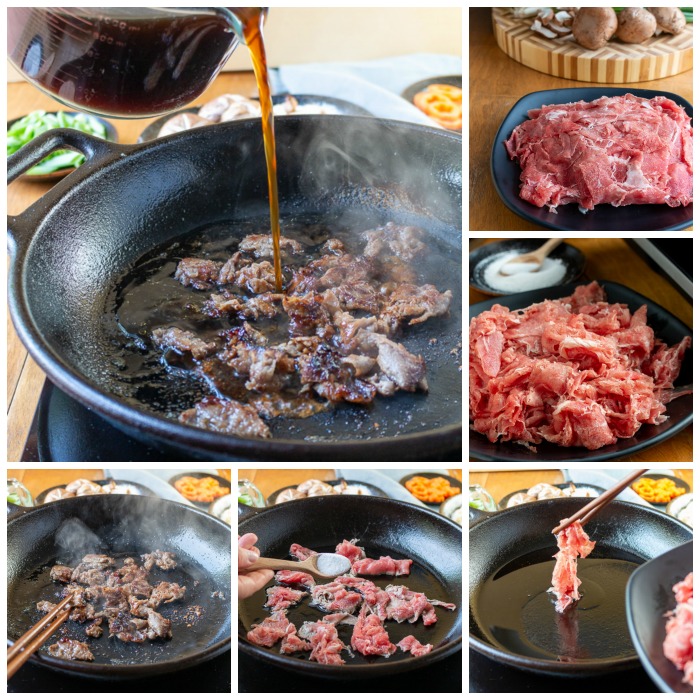
Where's the Beef?
Do you know where all the delicious flavor comes from in the recipe? It is all the little crispy bits from the beef caramelizing on the bottom of the pan. After we add the broth, we use our chopsticks get all the delicious bits and bobs off the bottom of the pan.
We used chipped thinly sliced beef for this recipe by Kroger. They call beef shaved steak and it is the same cut as what you would find in a cheese steak sandwich. In Japan, you would use a delicious expensive fatty beef thin slices that are super expensive. However, you can use thinly sliced short ribs or other beef if you cut it super thin. If you are slicing your own beef, freeze your beef first as it makes it easy to cut it super thin.
If you are looking for other nourishing Japanese recipes, be sure to try our…
Pepper Lunch Steak Rice Sizzle
Jenga Japanese Sweet Potato Fries
Hungry For More? Subscribe to our Newsletter and follow along on Facebook, Instagram and Pinterest for all the latest updates.
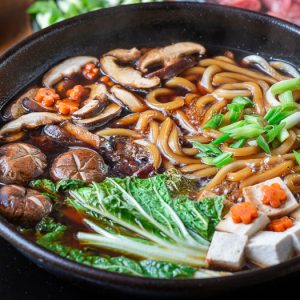
Sukiyaki Beef Udon
Ingredients
Sukiyaki Sauce
- ½ cup mirin
(Mirin is Japanese sweet wine. Aji-mirin is what we used. As a substitute, you can just use dry sherry or sweet marsala. Or you can dissolve a small amount of sugar in a little white wine or sherry) - ½ cup sake
- ⅓ cup soy sauce
(tamari) - 2 cups dashi broth
(we used dried hon-dashi and added water to the granules as directed) - 2 teaspoon granulated sugar or low glycemic sugar alternative
Sukiyaki components
- 1 tablespoon oil
- 12 ox sukiyaki beef
sliced paper thin (chuck ribs, sirloin steak, shaved beef with slight marbling or wagyu beef) - 2 teaspoon granulated sugar or low glycemic sugar alternative
- 8 oz tofu firm- diced (optional)
- 2 cup napa cabbage cut into 2-inch slices (or other fresh greens of choice)
- 8-12 shiitake mushrooms fresh whole or sliced
- 3 green onions cut in slices
- 1 carrot
peeled and sliced - 1 pack udon noodles per person frozen (soaked in hot water and drained and set in individual bowls just before serving)
Instructions
- Prepare your portable burner and iron skillet, hot pot device or all in one cooker in the center of the kitchen table. (If you do not have a portable burner or all in one cooker, you can make on the stovetop.)
Make your sukiyaki sauce.
- In a bowl combine the following items; mirin, sake, soy sauce, dashi broth and sugar or sugar alternative of choice. Give it a taste. If you like your broth a little sweeter, add a little more sugar. On the other hand, if you want it saltier, add a little more soy sauce. The flavors of the broth will intensify while they are cooking. Our preferred method is to wait and taste the broth after you add the other ingredients and reassess. Stir well and set aside.
Prepare the components for your Sukiyaki Beef Tofu.
- Dice your tofu into 1-inch cubes. Set Aside.
- Slice your napa cabbage into 2-inch sections. Set aside.
- Prepare your mushrooms by either slicing or keep whole and removing the stem. If you desire, you can take a moment to make a flower design on top of each whole mushroom. Take the edge of a sharp paring knife at a 45-degree angle and slice both sides to create a small crevice on the top of the mushroom. Criss cross the process 3 times to make a flower design. Totally optional but super cute. (See post above for step by step tutorial). Set aside.
- Chop green onions and set aside. If you can find negi (Japanese leeks) this is preferred. However, green onions or western leeks work fine as well.
- Wash other green vegetable of choice. Traditional sukiyaki is usually made with chrysanthemum leaves. However, this can be very difficult to find outside of Japan so other green vegetables are welcome. Clean out your crisper. Any green vegetable would be delicious in this recipe. Set aside.
- Slice carrots and set aside. We used a cute little flower stamp for our carrots but you can just slice as desired.
- Set your frozen udon noodles in a large bowl. Pour boiling water over the noodles and allow them to unthaw for just 1-2 minutes. Drain, rinse with cool water and drain again. Set aside.
Cook your Sukiyaki Beef Udon
- Heat oil in iron skillet on your portable burner or other hot pot all in one device. Add thin beef slices and 2 teaspoons of sugar (Until lightly golden brown) (A shabu shabu or hotpot type of pan works great as this is usually served and cooked at the dining room table and cooked in front of your guests)
- Pour prepared Sukiyaki sauce pour over beef. Turn up your heat to high to bring to a light boil.
- Add the prepared tofu, mushrooms, carrots and udon noodles first. Then add napa cabbage and green onions to the sukiyaki broth pot. Taste the broth after you add the other ingredients and reassess. If you want it sweeter, add a little more sugar. On the other hand, if you want it savorier, add more soy sauce. If it is too salty for your palate, add a little more dashi or water. The sauce flavors intensify with cooking. We like to check on it about 5-8 minutes into the cooking process. Cooking time is about 10-15 minutes.
- Ladle beef and vegetables and broth over the udon noodles and serve at table. Add more of the vegetables and mushrooms a little at a time and cook to serve as people help themselves to the sukiyaki. (Purpose of cooking just a little at time is to keep the items fresh and not overcooked)
- Enjoy Sukiyaki Beef Udon with family and friends around your kitchen table. If you desire, you can dip sukiyaki components into a pasteurized beaten egg. (This is the traditional method in Japan)
- Eat sukiyaki with chop sticks and make sure you slurp your noodles. In Japan, slurping your noodles is a complement to the chef. (To really enjoy noodles while they are hot, one must slurp them in while take a cooling intake of breath. Go ahead and give it a try).


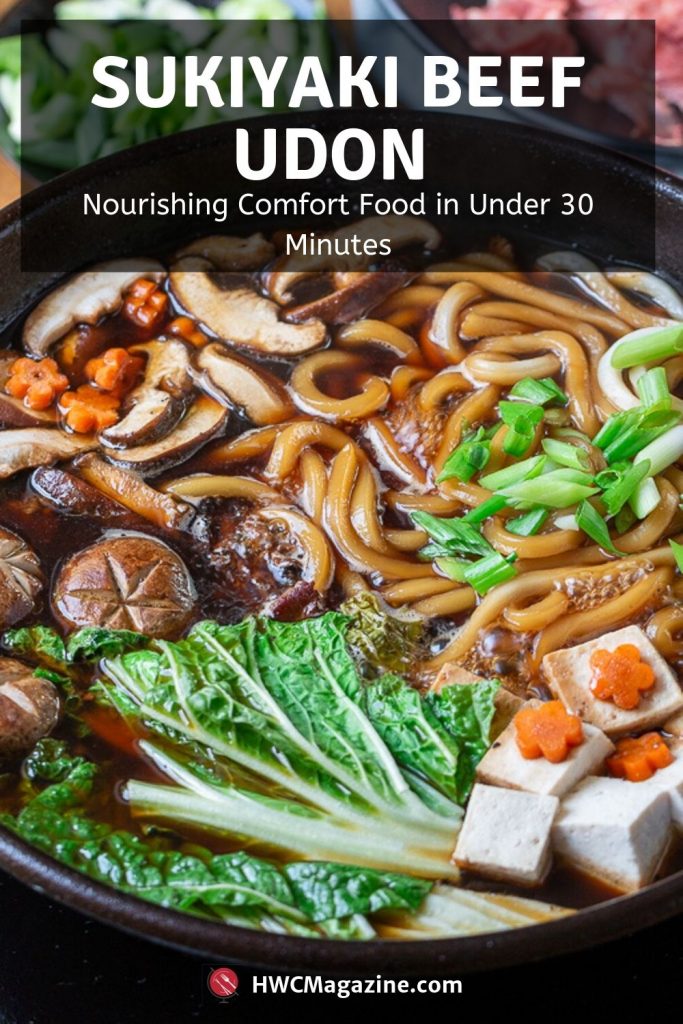
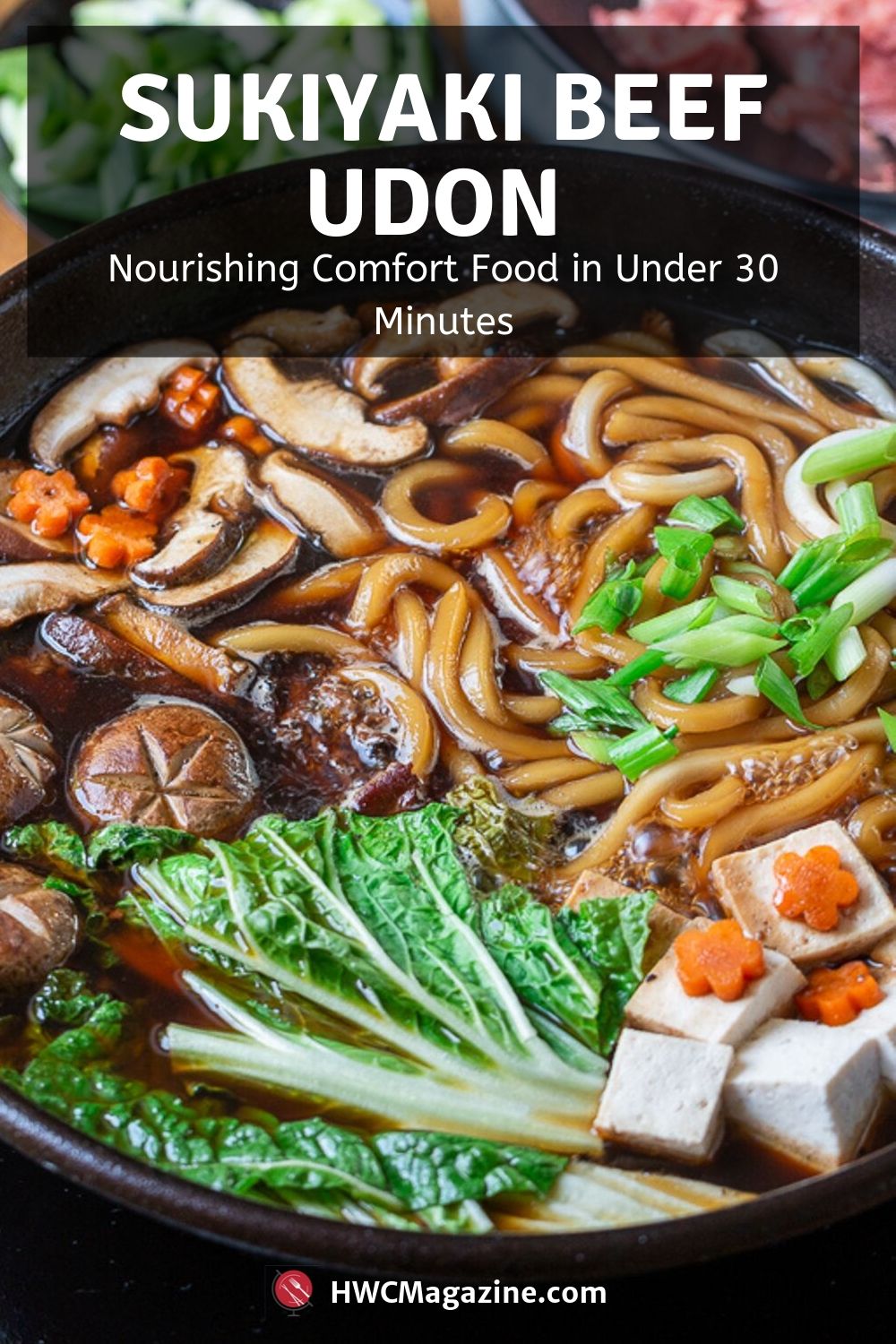
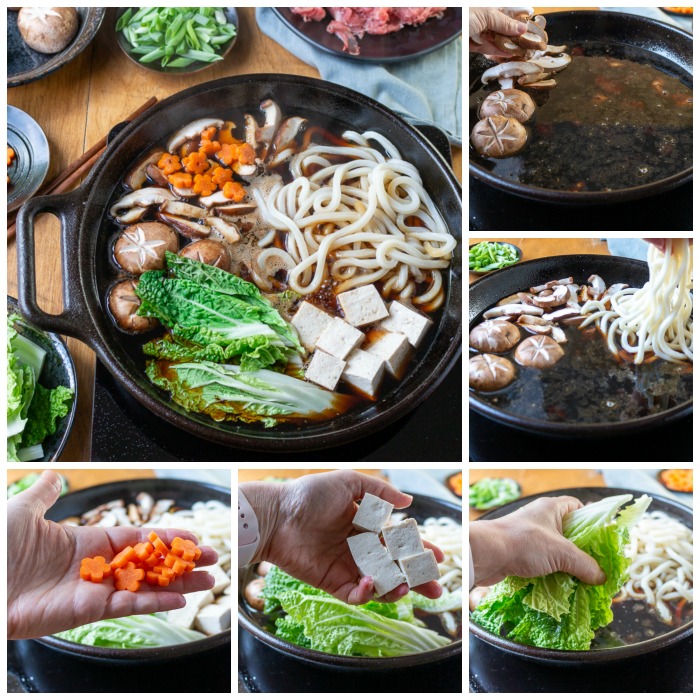
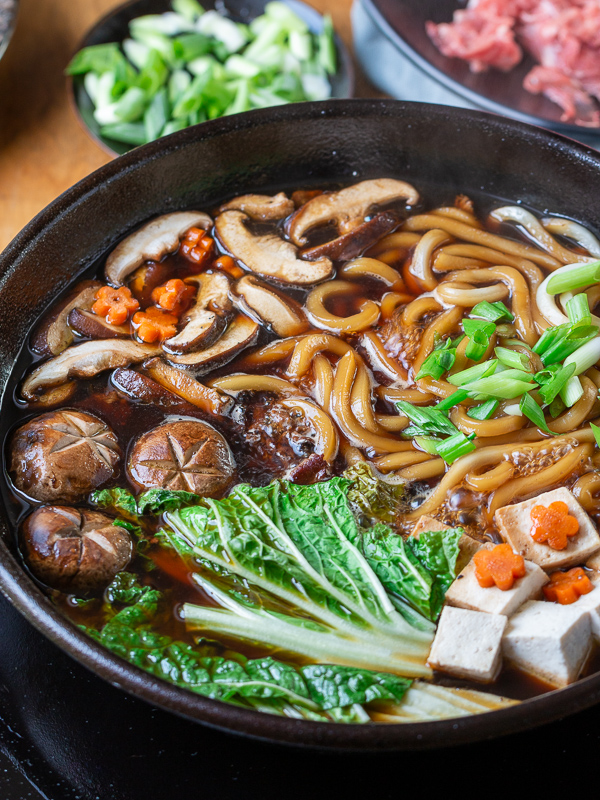
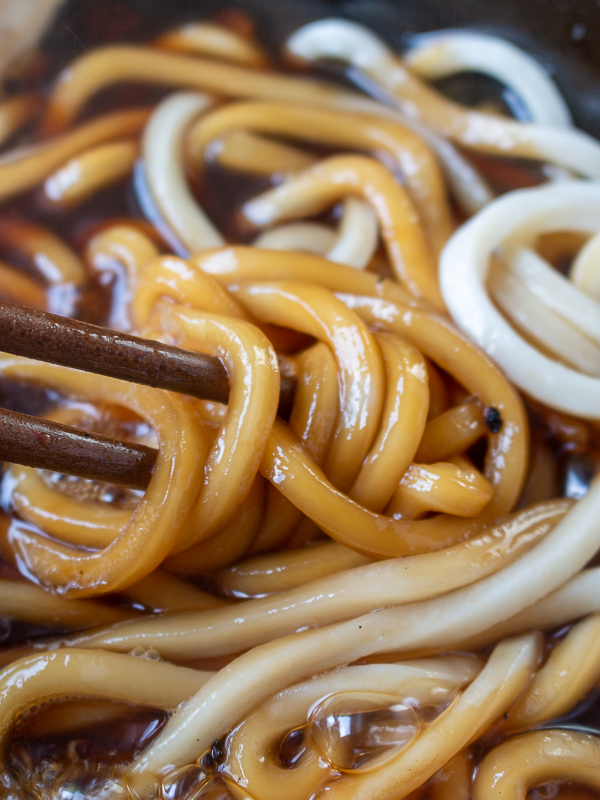
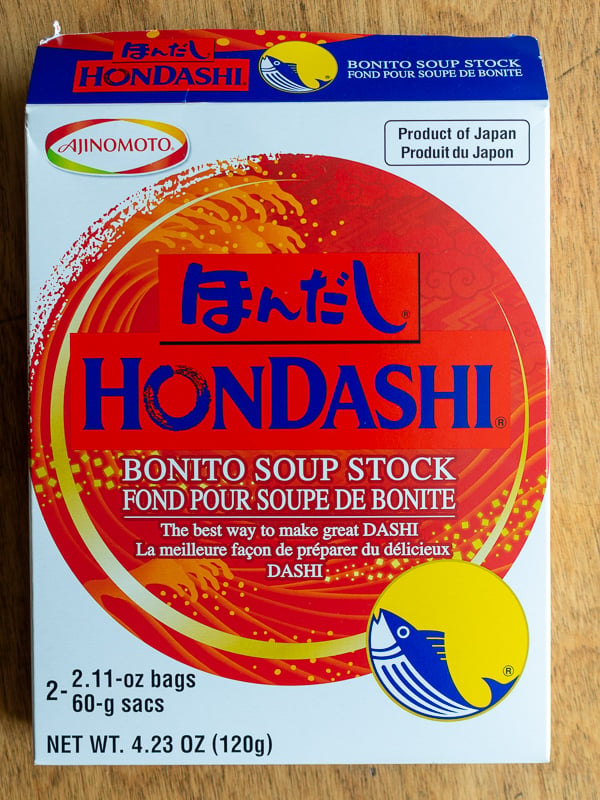

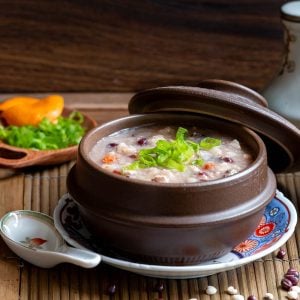

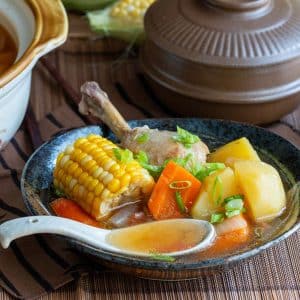

Eha Carr says
Already commented a few months back - may I come back ! My two daughters, Siiri and Kersti, first came with us to Japan when they were just 5 and 7. We arrived from HK which they were in tears to leave. Tokyo for a week was a wee overwhelming even with my in-laws in tow, but then we had some 10 days in Kyoto (where I would love to be now !). Hillside Japanese inn where we had food prepared in the rooms and they could not overcome the joy of sleeping on the floor Oh, we had SO many of the fabulous Kyoto-style brilliant restaurants planned . . . until they were shown how to cook sukiyaki in their own room ! What do you do when you have two perfectly behaving littlies begin tugging at your skirts by about 3-4 pm, ardently looking into your eyes . . . 'Mpm, Dad, . . . . Gran'ma . . . sukiyaki PLEASE tonight . . . . hmm, next time we did not bring the young ladies and got to the Kyoto fare 🙂 ! Lesson: No [problems with vegetables if the kids can cook their own !!!!!
HWC Magazine says
What a lovely story Eha. It is so nice to look back at those fond moments. Our kids grow up so fast, don't they. One minute they are tugging on your skirt and the next minute they are off to a University. Kyoto is a very special place and THE PLACE for JAPANESE PICKLES and of course sukiyaki. We have a thing for Japanese pickles --Somewhat of an addiction. We have tested our fair share of pickled veggies all over Japan and Kyoto wins for best pickles. So if you ever find your way back to Japan, grab another delicious pot of sukiyaki and pickles and you will be one happy camper. Stay well and take care
Eha Carr says
*laugh* I did not know about the pickles ! Have friends in Kyoto . . . . gosh, have to ask them !! Thanks . . . and I surely shall be thinking of you in a few hours time . . . blessings . . .
HWC Magazine says
Hi there Eha... I guess the secret Japanese pickle assessment is out... LOL Did you know at the ground floor (B1) of most large department stores in Japan that is where they have all of their delicious foods and PICKLES on display. You can trial them too. One of our favorites is pickled yuzu diakon radish. mmmmmm....
Ken says
This looks so good and so much easier than I would have thought. When I lived in Japan I always had these deep filling noodle bowls in the winter time. There were lots of different types. Oddly some stores would have lines all the way down the street, while others had no lines at all. Missing Japan
Becky Shi says
This is very delicious. I think the original style comes from China - but many things in Japan are borrowed from the mainland. Japan dishes are so refined and delightful -- always look very good for your eyes.
HWC Magazine says
Hello Becky, thanks for stopping by with a comment. I bet you are right. Many things have been borrowed from the Chinese just like Kanji as a replacement for Chinese Traditional characters. However, one striking difference is the attention to detail in plating and presentation. We hope you give recipe a try soon. Take Care
Cal says
If I learned anything from this recipe its that I NEED to get a carrot cutter! Hello Amazon.
But seriously, this looks so delicious,
HWC Magazine says
Cal, thank so much and also thanks for a good giggle. You are right! Hello Amazon as this little carrot cutter is super cute. Stay well and take care
Barb says
Thank goodness for your alternate ingredient cross reference.
Thanks you so much.
Cant wait to make this after the next Asian Market trip
HWC Magazine says
You are very welcome Barb! Sukiyaki beef udon is so comforting during the cooler weather.
Larry says
Gonna earmark this for the coldest winter Saturday
HWC Magazine says
Thank you Larry. Old man winter is here, at least in parts of the world. This sukiyaki will warm you right up. Take Care
Eha Carr says
Oh Lordie - I have not made sukiyaki for many a day but you do take me back. My many business trips to Japan began at a time few Australians had visited the Land of the Rising Sun but we were becoming super interested in food, especially that of Asia . . . I became quite well known in Sydney-town for my sukiyaki parties . . . a lot of prep work but I had four table burners so could invite 16 or at a pinch 20 friends around four tables to cook their own. Did not know about 'styles' but Kansai it must have been ! Well i Still have a couple of burners stashed at the back of a kitchen cupboard, so once we squish that darn virus under our feet . . .there is a fun idea !!!! Thanks !
HWC Magazine says
Hi there Eha! Sukiyaki parties sounds like so much fun. How awesome- 4 table burners! You go girl. Now that's a party. We have one portable burner... and 4 burners on an island cooktop so I guess everyone could gather around. Looking forward to turning the corner around this virus... Stay well and take care
Karen says
We made this for dinner this weekend. Your helpful step by steps and easy instructions were really helpful. Even our picky eating children lived this delicious recipe. Will be making again.
HWC Magazine says
Thanks so much Karen. It is such a relief to find a recipe, even the kids enjoy. Meal time is stressful enough. Wishing you a super week ahead.
Zoe says
I love trying new Asian inspired dishes - this looks really delicious. I have some incredible Asian markets in my city and visit often. Sometimes I buy interesting new ingredients and then try to find out how to use them. This doesn't look too hard... I'll have to give it a shot 🙂
Thank you for sharing.
Healthy World Cuisine says
Good news for you is essentially the ingredients are so easy and simple that you can purchase them in a regular grocery store. It is so funny as I have the opposite problem living here in Hong Kong. At any of the local grocery stores, heck even at the 7/11, I can pick up 1000 year old eggs, bizarre vegetables, and chicken feet but goodness gracious if I want something so simple such as bread or milk I might be out of luck. Take Care
Dawn says
No jet lag for Mom's that is for sure!!!
Healthy World Cuisine says
Indeed! Moms are never allowed to get sick or ever have jet lag.
Rufus' Food and Spirits Guide says
This is so comforting looking.
Healthy World Cuisine says
Thank you. Do you think we should pair up this kind of dish with some Sake? What is your advice for spirit to complement this dish? Take Care
Just A Smidgen says
I love how food can bring a sense of connection.. I'm glad to have found your blog!
Healthy World Cuisine says
Thanks for stopping by Just A Smidgen. I am now following your cooking blog as well. Love it!
thefooddoctor says
This sounds like my kind of meal!
You think it can be made without the wine?
Healthy World Cuisine says
Feel free to leave out the wine/sake, it is traditional in Japan to make it this way as these ingredients are readily available. You may consider adjusting the other liquids by adding more Dashi, soy sauce, sugar etc so that you have enough comforting broth. Hope that helps. Take care.
Healthy World Cuisine says
Thanks Jasline.
Jasline says
I love sukiyaki! Your photo's making me really hungry!